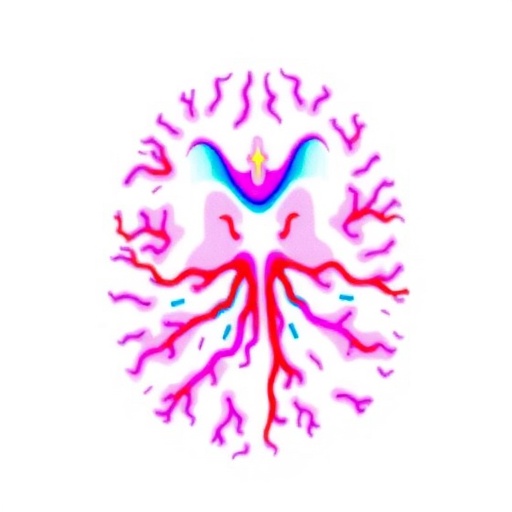In a groundbreaking study published in BMC Neuroscience, researchers Liu, S., Li, J., and Hua, R. delved into the complexities of the human brain’s architecture, particularly focusing on a critical yet often overlooked feature: perivascular spaces (PVS). These spaces play a vital role in the brain’s drainage of waste products and location of cerebral spinal fluid, yet remain poorly understood in terms of their visualization and potential implications for neurological disorders. The advent of advanced imaging techniques, particularly 5-Tesla (5-T) magnetic resonance imaging (MRI), has opened new avenues for scientists to explore the intricate workings of the brain and its vascular system.
For many years, researchers have struggled to obtain clear images of perivascular spaces due to limitations in resolution and sensitivity that traditional imaging methods offered. However, the study led by Liu and colleagues utilized a 5-T MRI scanner, renowned for its enhanced magnetic field strength and improved spatial resolution. This innovation allowed the research team to visualize PVS in unprecedented detail, revealing complexities and anatomical features that were previously concealed.
The significance of this study cannot be overstated. Understanding PVS could have far-reaching implications, particularly regarding how the brain manages waste removal and how these pathways may be linked to various pathological conditions. For instance, the accumulation of neurotoxic substances is thought to contribute to neurological disorders such as Alzheimer’s disease. The ability to observe these spaces more clearly could be pivotal in unraveling the pathophysiology of such diseases, potentially influencing both diagnosis and treatment strategies.
The researchers conducted their study on a cohort of healthy adult volunteers, employing rigorous methodologies to ensure the accuracy and reliability of the imaging results. The volunteers were subjected to the high-resolution scans, which not only elucidated the perivascular spaces but also provided insights into how they correlate with surrounding cerebral structures. Each image captured under the scanner served as a piece of a larger puzzle that is the human brain, further emphasizing the significance of advanced imaging techniques.
One of the remarkable findings from this research was the variability in the anatomical features of the perivascular spaces among participants. These variations suggest that individual differences in brain vasculature and function could have important implications for personalized medicine. The researchers noted that understanding these differences may aid in predicting why certain individuals are more susceptible to neurodegenerative diseases than others. Such insights could pave the way for more tailor-made therapeutic approaches based on individual neuroanatomical characteristics.
Another key aspect of this study is its potential to reshape our understanding of cerebral blood flow. It is well established that cerebral blood flow is critical for brain health, and any disruptions to this flow can lead to significant cognitive impairments. By visualizing the perivascular spaces, researchers may uncover new dimensions of the brain’s vascular system, which could lead to novel targets for intervention in cases of altered cerebral blood flow. This could be particularly relevant in conditions such as stroke, where timely restoration of adequate blood supply is paramount for minimizing damage.
The researchers also highlighted the importance of the interstitial fluid flow in the brain, as it closely interacts with perivascular spaces. This fluid flow is essential for the clearance of metabolic waste and could play a crucial role in maintaining neuronal health. Abnormalities in this clearance mechanism have been implicated in several neurodegenerative diseases, calling for a greater understanding of how these interstitial flows operate in conjunction with PVS.
For scientists, the detailed visualization offered by the 5-T MRI images represents an exciting opportunity to explore further avenues of research. Future studies could focus on mapping the connectivity between PVS and neuronal networks, illuminating how these spaces might influence brain function and contribute to cognitive performance. This line of research could uncover novel biomarkers for a range of neurological conditions, aiding in earlier diagnosis and potentially more effective treatment strategies.
Furthermore, the implications of this study extend beyond the realm of neurodegenerative diseases. Conditions like multiple sclerosis, which is characterized by neuroinflammation, may also be influenced by the function and structure of perivascular spaces. By utilizing the advanced imaging capabilities of 5-T MRI, researchers can investigate these correlations, leading to a deeper understanding of the complex interplay between vascular health and neurological function.
Additionally, the research team has taken a significant step in refining the methodologies used to visualize PVS, which may encourage further studies in different populations, including those with existing neurological conditions. By applying the same rigorous imaging techniques to clinical populations, researchers may uncover how pathology alters PVS morphology and function, ultimately contributing to disease progression.
One of the most compelling aspects of this research is the validation of 5-T MRI as a tool for both basic and applied neuroscience. As the field of neuroscience continues to evolve, the integration of advanced imaging technologies represents a transformative shift that necessitates a reevaluation of existing paradigms. The ability to observe the brain’s microanatomy, including features like perivascular spaces, is essential for driving innovation within both research and clinical settings.
In summary, the groundbreaking work by Liu, Li, and Hua serves as a shining example of how advanced imaging techniques can reveal the complexities of human anatomy. Their findings not only shed light on the perivascular spaces but also highlight the intricate relationships between brain structure and function. As the field pushes forward with innovations in technology, the implications of this research promise to be profound, potentially reshaping our understanding of neurodegenerative diseases and paving the way for new therapeutic interventions.
In conclusion, the visualization of perivascular spaces using 5-T MRI represents a significant leap forward in neuroimaging. This innovative study underscores the value of advanced technological resources in enhancing our understanding of the brain’s vascular system and its implications for health and disease. Continued research in this area will likely yield further insights, establishing robust connections between brain anatomy and neurological function, ultimately contributing to the overarching goal of improving brain health across populations.
Subject of Research: Perivascular spaces in the human brain
Article Title: Visualization of perivascular spaces in the human brain with 5-T magnetic resonance imaging
Article References:
Liu, S., Li, J., Hua, R. et al. Visualization of perivascular spaces in the human brain with 5-T magnetic resonance imaging.
BMC Neurosci 26, 18 (2025). https://doi.org/10.1186/s12868-025-00925-z
Image Credits: AI Generated
DOI: 10.1186/s12868-025-00925-z
Keywords: perivascular spaces, 5-T magnetic resonance imaging, neurodegenerative diseases, cerebrovascular health, interstitial fluid flow.
Tags: 5-Tesla MRI imagingadvanced neuroimaging techniquesBMC Neuroscience publicationbrain architecture researchbrain waste drainage mechanismscerebral spinal fluid visualizationLiu et al. neuroscience studyneurological disorder implicationsperivascular spaces in the brainsignificance of perivascular spacesspatial resolution in MRIvascular system in the brain




